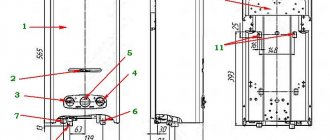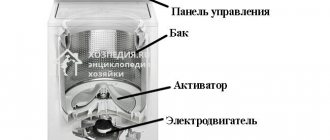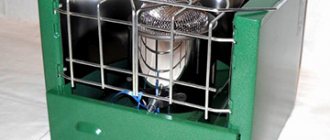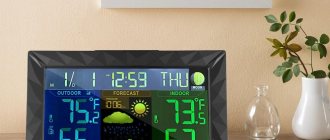Oil radiators come in flat and accordion type, and the former are difficult to find. The heater configuration was not chosen by chance. We have already told you how to assemble and disassemble a heating battery, despite the external similarity, the number will not work with an oil heater. The sections are welded to each other, the outer ones differ from the middle ones. Therefore, you cannot confuse what to put where. Assembly is carried out on machines, but we believe that an experienced blacksmith could master the task and lengthen the heater. The action would provide favorable conditions for the operation of the heating element. The power of the oil heater does not change; the temperature of the oil and the coil could be slightly lowered by increasing the volume. An ordinary citizen cannot change the design of an oil heater.
How does an oil heater work?
The circuit of each oil heater is similar. The body of the heating unit is metal and consists of several sections that are hermetically joined together. The inside of the structure is filled with mineral oil, and the outside is covered with a layer of powder paint, which is very durable and resistant to mechanical damage.
The package includes:
- heating element (heating element);
- thermostat;
- heating regulator;
- wires;
- overlay panels.
The operating principle of any oil heater is the same. First, the wire is connected to the network, the heating element is heated, then, under the influence of thermal energy, the oil is heated, then the housing. Heat from the heated body is transferred to the air that comes into contact with it, it heats up and rises. According to the convection principle, cold and hot air are mixed, and its temperature rises. Some models are equipped with a fan to make the air change more intense.
Thermal energy heats the oil
Heating devices have different power levels and differ in the number of sealed parts. The room will heat up faster if the unit has more sections. At the same time, the heater is heavier and larger in size. All models are equipped with wheels with which the devices are moved, so the mobility of the heater does not depend on its size.
Oil convectors have a number of operating modes. For this purpose, switches are installed, and on some models there are touch control panels or LCD monitors, which show data on the operation of the device.
Classification of oil radiators
Oil electric heating devices are classified as follows:
- Floor radiators. The most popular and widespread type of oil heaters. The device is equipped with special wheels for ease of movement. Often such devices are universal in terms of installation type, i.e. they allow the use of both floor mounting and wall mounting.
- Wall radiators. Using the brackets that come with these heaters, they are hung on the wall. Compared to floor-mounted structures, wall-mounted modifications are less powerful and have lower heat transfer.
- Baseboard heaters. The latest modified development of the device with wall mounting. The device is placed at the bottom of the wall, which ensures good air circulation. It is used as a full-fledged heat source, which is an alternative to central heating.
- Heaters with thermostat. In order to ensure uninterrupted operation of the device for a long time and reduce energy consumption, electronic thermostats are built into the heaters, maintaining the set temperature and eliminating possible changes.
- Heaters with fan. To speed up air heating, the devices are equipped with built-in fans, which additionally redistribute the flow of air masses. A negative point inherent in these varieties is the noise when the fan operates.
How to disassemble an oil heater?
Before repairing the heater, you need to determine the cause of the breakdown. To do this, you will need to disassemble the unit, although outwardly it seems that the oil heater cannot be disassembled, since it is monolithic.
Important! Before starting repairs, the device must be disconnected from the network. The structure cannot be turned on until it is fully assembled.
Disassembly procedure
There are many different models of oil heaters; there is no exact algorithm for analysis. But we can highlight general rules with the help of which the unit can be disassembled faster.
It is not difficult to disassemble an oil heater
First you need to carefully study the convector control panel. The design of a cheap oil heater is similar to an expensive one. Disassembly begins with the stage of unscrewing the bolts and removing fasteners. On some models, instead of screws, there is a plastic panel that is latched with a spring. In this case, you need to feel the latch on the panel with any wedge-shaped object (preferably made of plastic), press it harder and thereby bend it.
If the repair is being carried out for the first time, it is advisable to take a photo of the entire process. This will help to correctly reassemble the disassembled unit after repair. It is also recommended that when removing bolts and screws, lay them out in the order in which they were unscrewed. This will allow you to correctly screw them back into the radiator, in the correct sequence.
Criterias of choice
To choose the right equipment, you need to decide in advance on the desired characteristics.
Power
Please note that the higher the indicator, the more electricity the equipment consumes. The calculation is made based on the tasks assigned to the battery and the area.
According to this characteristic, all devices are divided into three categories:
- low-power – 0.5-1 kW;
- average power – 1-2.5 kW;
- high-power – 2.5-3 kW.
Can an oil heater explode?
Oil is not a flammable liquid, so there is only one answer: oil units do not explode. If the thermostat breaks, such an electric heater will overheat, the housing will depressurize, and hot oil will leak, which can cause a fire.
An oil heater may cause a fire.
There are rules for operating oil structures:
- Do not use the devices in bathrooms or other rooms where there is high humidity.
- It is prohibited to cover the heater with fabrics. Overheating will occur and oil will begin to leak.
- The device should be located at a distance of half a meter from the wall, since there is a thermal relay that turns off the device in order to protect it from overheating.
- The heater must be positioned vertically during operation, because inside it is not completely filled with oil. If you put the device down, the heating element will be exposed, which will lead to depressurization.
- Do not move the unit by pulling on the cord. It will come off and there will be a short circuit.
- The cord should not come into contact with a hot surface, as this will cause the insulation to melt.
- In winter, the unit should be kept only in warm rooms.
- Do not use the device with a broken overheat sensor.
There are no categorical contraindications to leaving an oil heater overnight. This is one of the safest devices. But it is still recommended in such cases to purchase products with automatic shutdown.
Precautions for use
In order for household electric oil heaters to function effectively, and to bring you, as users, joy and comfort, you should follow some easy-to-follow precautions:
- Remember that oil radiators should not be placed in rooms with high humidity (such as a bathroom).
- Do not touch or place the power cord on the hot body of the device, because the “jacket” of the cord may melt.
- Electric oil heaters should always be in a vertical position.
- It is better not to connect the heating unit using an extension cord, since no one has ruled out overheating during operation.
- An electric oil heating radiator should be located as far as possible from products that are easy to melt. It is advisable to place furniture at a distance of at least half a meter.
- Do not pull electric oil radiators by the power cord (a special handle was invented for this purpose!).
- It is better not to store the device on the balcony or in the closet. This may contribute to its failure.
The recommendations are not complicated, however, if followed, they will help protect you and your home from unpleasant situations, fill the room with warmth and create a favorable microclimate.
You can read about possible oil radiator malfunctions, methods for diagnosing and eliminating them here.
What kind of oil is poured into the oil heater, the efficiency of the oil heater
Many people are interested in what kind of oil is poured into a floor-mounted oil heater. Transformer oil is poured into the sections. It is heated by a heating element and circulates. The oil temperature can reach one hundred degrees Celsius.
The heat output of the heater is very high. To increase efficiency, fans are installed on radiators, and special water evaporators are installed to prevent the air in the room from drying out.
The efficiency factor (COP) of the oil heater is 80%. With proper operation, the service life of a floor oil heater is more than twenty years.
The oil heater contains transformer oil
Technical parameters of the oil device
During operation, some important requirements must be observed. The device must be stable and the cord must not be strained. Install in a place out of the reach of children or secure it. Avoid exposure to moisture. Do not operate near flammable materials. Do not use after the service life has expired.
Compliance with these rules will allow this useful device to work for a long time and bring joy to its owners.
Average score of ratings is more than 0
Share link
Comments There are no comments yet, but you could be the first...
How to choose a device?
Heating problems in the cold season can arise both for residents of city apartments and private country houses. The problem that arises must be solved in an emergency mode using electrical equipment.
Why not take care of buying an oil heater in advance? These devices are very reliable and safe to use. The heating elements are closed, so there is no risk of fire. These designs were invented a long time ago, the principle of use has not changed.
The latest models have added several new features:
- light indicators;
- timers;
- fans;
- humidifiers;
- thermostats;
- overheat shutdown sensors.
Oil heaters are divided into several types:
- Floor-standing. These are the most common radiators.
- Wall flat. They consume energy very economically.
- Tabletop. These are low-power devices and have low heat transfer.
Some models have a fireplace effect. They operate silently and quickly heat the room. They have drafts installed on both sides, so the heated air circulates very quickly.
Modern models have blocks with programs and timers. If there is such a block, you can set the on and off times. As a rule, new units are controlled remotely and have an emergency shutdown sensor.
Oil heater does not take up very much space
When choosing a device, consider the following factors:
- Power. This is the main indicator. A power of 1 kW is enough to heat a room of 10 square meters. meters with a three-meter ceiling. If there are windows or doors, then we add 0.2 kW for each element. In a room from 30 sq. meters you need to install several such devices.
- Dimensions. This indicator depends on the number of modules: the more modules, the larger the structure, the power of the device increases and the area of the heated room increases. This must be taken into account when choosing such equipment.
- Design features. This refers to additional functions that improve the ease of use of the device and increase the quality of its work. For example, the presence of a network indicator, temperature control mode, etc.
- Manufacturer. The manufacturer should also be taken into account. Brands that have been on the market for a long time are well-known and recognizable. They guarantee the quality of their products and long service life.
When choosing a heater, you need to take into account that the more functions installed on the equipment, the more expensive its cost and the more energy it will consume. Also, brands from well-known manufacturers are more expensive. You need to determine the optimal price for yourself, and also take into account the functionality of the device. This will allow you not to make a mistake in your choice.
Advantages and disadvantages
These devices are completely safe. They have no exposed heating elements and therefore accidental fires are virtually nil. Such heaters were invented quite a long time ago and the principle of operation, as well as their design, have not changed. But modern models have many functional additions, for example:
- Thermostats that allow a smooth transition to different heating modes.
- Sensors for switching off the device when it overheats.
- Light indicators.
- Operating mode switches to set the required power in order to save money.
- Timers for turning the device on and off at a certain time.
- Built-in humidifiers.
- Built-in fans to increase the speed of heating the room.
Oil radiator devices are durable in operation and can operate for up to three days without being turned off.
Their disadvantages (which can easily be transformed into advantages) include:
- It takes a long time to warm up the entire room, but with a built-in fan, the heating process increases significantly, and the room heats up much faster.
- They are quite heavy, but they have good mobility due to the presence of special wheels for movement.
Popular models of oil heaters
Let's look at the most popular heater models.
Ballu BOH/CL-09
Consists of three modules, operates in three modes with power from 600 to 1500 W. Can heat a room of twenty square meters. Equipped with a thermostat to maintain the set temperature for a certain time. For ease of movement it is equipped with wheels. Filled with mineral oil. Refers to environmentally friendly products.
The cost of such a device is from 2 to 4.5 thousand rubles.
Delonghi KH 770920 HOR
The unit is assembled from nine sections. It has cells to maintain the desired temperature, due to this it does not overheat. The device can heat a room up to 60 square meters. meters, has a thermostat, operates with a power of up to 2500 W. It has wheels that can be folded and a handle that can be moved freely.
The cost of this model varies from 5 to 6.5 thousand rubles.
Oil heater Delonghi KH 770920 HOR
Timberk TOR 21.1005 SLX
The structure consists of 5 sections. Capable of heating a room of 15 square meters. meters, the power of the unit does not exceed 100 W. Thanks to its small size, it is convenient to carry. Includes a folding handle, a power cord about 2 m long and wheels. An overheating protection system and indicator are installed.
You can buy such a model for 1,500 - 2,600 rubles.
General Climate NY18LA
Operates with a power of up to 1800 W, this allows the device to heat up to 18 square meters. meters. The model is controlled mechanically, has an anti-freeze function and a light indicator.
The cost of such a device is reasonable, ranging from 1,900 to 4,000 rubles.
Vitek VT-2122 GY
The thermostat of this unit is designed to heat a room up to 25 m2. The heater is floor-standing and can operate in different modes, in which the power can be set from 800 W to 2000 W. This is the best option for a small apartment. The heating temperature can be adjusted and is equipped with a light indicator.
The cost of such a unit ranges from 2,600 to 4,100 rubles.
POLARIS CR0920B
This device has a stylish design. Operates with a power of up to 2000 W, consists of nine modules. There is a power adjustment function. The package includes wheels for movement, as well as a folding handle. The area of the heated room is up to 20 square meters. meters. It is possible to connect the fireplace effect. It is also equipped with a special device that is built-in for winding the cord. Costs up to 3000 rubles.
SUPRA ORS-05-P2
A very compact unit, easy to move, easy to operate. The power regulator has three levels and operates with a power of up to 1000 W. Consists of five modules. Mechanically controlled, power can be adjusted.
Refers to budget options: its cost ranges from 1,800 to 2,900 rubles.
Electrolux EOH/M-3105
The thermostat of this model was developed using highly environmentally friendly oil HD-300, which was first subjected to additional purification in several levels. This unit has three operating modes with different powers (from 400 to 1000 W). The largest area of the heated room is 15 square meters. meters.
It has additional sensors to monitor the safety of use: overheating, tipping over, and is also equipped with a light indicator of the device status (shows on/off) and a special dust protection system. The cost is 2,600 - 5,600 rubles.
Ballu BOH/CL-09
The design consists of nine modules, mechanical control, operates in three modes, which allow you to change the power from 800 to 2000 W. It is a floor-standing device. Designed for a room up to 25 square meters. meters. To move the device there are wheels and a special handle.
You can buy such a model for 2,100 - 4,600 rubles.
Electrolux EOH/M-3221
The unit includes 11 modules, has a steel body, and the maximum possible power is 2200 W. Designed for use on 28 - 30 sq. meters. Equipped with a tip-over protection system, as well as an adjustable thermostat that allows you to set the desired temperature.
The package includes a handle for moving, a power cord, a built-in cable storage compartment and wheels that fold. High characteristics provide a cost from 3,400 to 7,700 rubles.
Oil heaters are very widely used in apartments, houses and office spaces, as they are very convenient to use and have high heat output. Therefore, it is recommended to purchase such a device in advance, before the cold weather begins.
Design Features
Let's consider what elements the design of an oil heater consists of. The radiator housing is made of metal with a thickness of 0.8-1 mm. The section plates are securely soldered to each other, ensuring tightness. On the outside, the metal of the case is coated with heat-resistant paint and white or black enamel.
The heating element (heating element) runs on electricity. It is located inside the device, which is filled with mineral oil to 85-90% of the internal volume. This is due to the fact that when heated, the liquid expands, filling the empty space.
The design of the oil heater is equipped with additional elements:
- Temperature regulator,
- thermostat,
- protective device that protects against overheating.
The radiator heating element is connected to the network using an electrical wire. Legs with wheels are attached to the lower part of the body, which are responsible for stability and convenience when moving the heater.
Some models have a plastic casing. It protects against burns if you accidentally touch the hot body of a working device. The protective cover is included or purchased separately.











